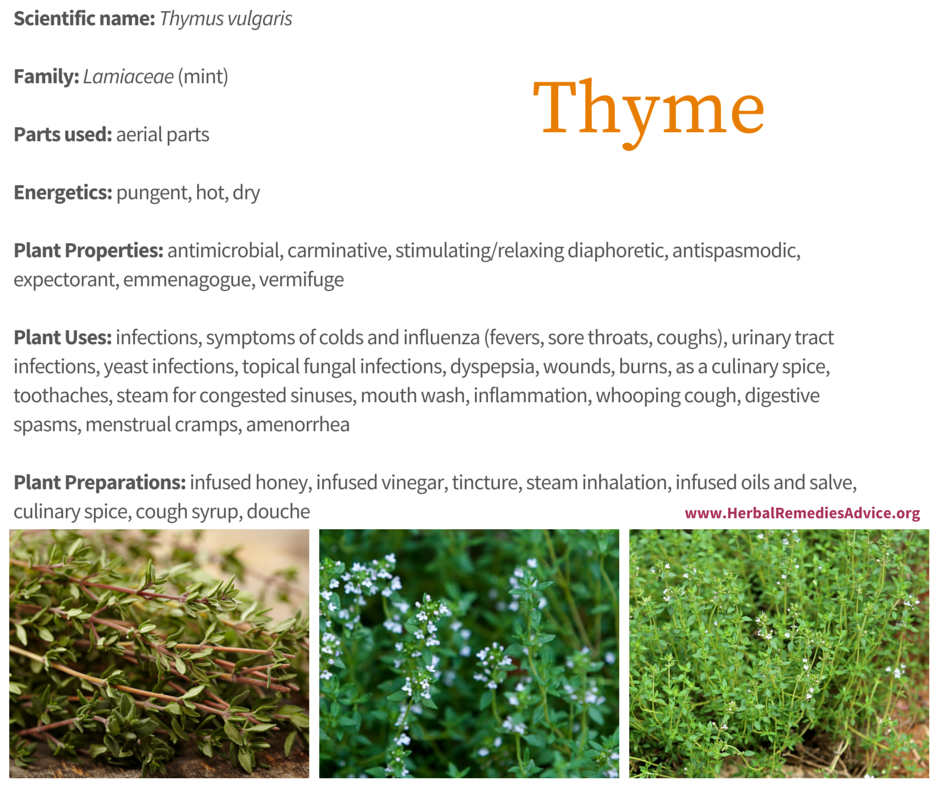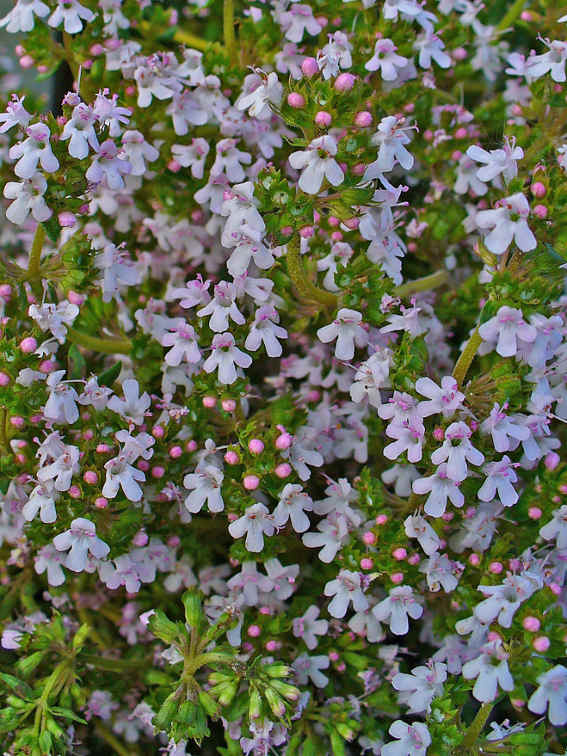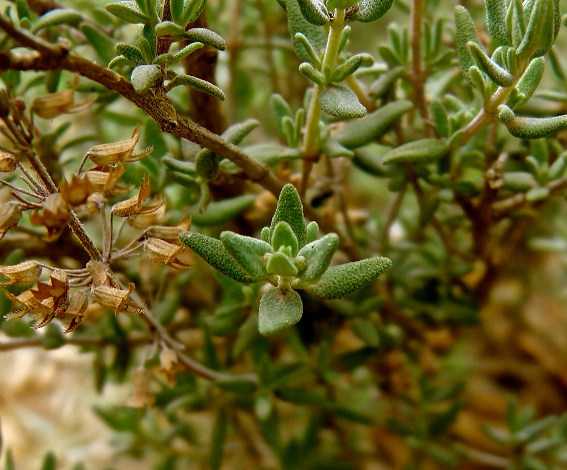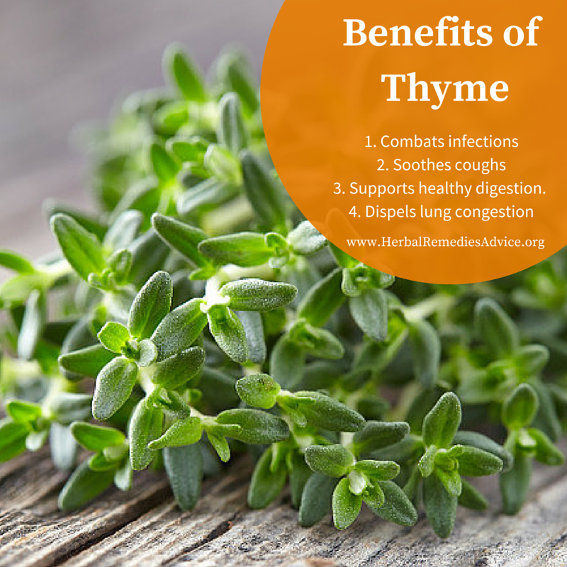Get weekly tips, recipes, and my Herbal Jumpstart e-course! Sign up for free today.
Thyme Herbal Remedies
Share this! |
|
It’s easy to love the taste of thyme in stews and roasts and sauces, but have you taken the time to really taste thyme? When you have really good quality thyme, it’s highly aromatic and very spicy and hot!
Tasting an herb and experiencing how it feels in your body when you take it as food and medicine is at the heart of herbal energetics. This system is a great way to really get to know the plants you’re working with, and to choose the herbs that are best suited to your unique body and conditions. In this episode I’ll walk you through the energetics of thyme (and why they matter!), and how you can use this system to choose the best herbs for you.
By the end of this episode, you’ll know:
► Why tasting herbs is such a powerful tool for assessing their quality, potency, and herbal actions
► The particular respiratory conditions that thyme’s gifts are best suited for (and how to know that, based on its taste!)
► Why thyme is such a helpful digestive aid
► Tips for harvesting thyme (and how to do so while still allowing the pollinators to enjoy its lovely flowers!)
► and so much more….
-- TIMESTAMPS --
- 01:40 - Introduction to thyme (Thymus vulgaris)
- 04:40 - Thyme for infections
- 05:56 - Thyme for the upper respiratory system
- 07:58 - Thyme for digestion
- 08:38 - Thyme for pain
- 09:29 - How to identify thyme
- 10:41 - Special considerations
- 11:27 - How to work with thyme
- 14:32 - Herbal tidbit
Transcript of the Thyme Herbal Remedies Video
Several years ago I was hiking in southern Provence, France with my friend and fellow herbalist, Christophe Bernard.
Christophe, who’s always about ten steps ahead on the trail, suddenly and excitedly called out to me and I hurried to catch up with him to see what he had found. Growing about six inches off the ground, with lots of tiny leaves, was wild thyme. We both crouched down to get a better view.
Christophe then went on to tell me that wild Provence thyme was far better than any garden thyme. My first thought was that he, being from Provence, was a bit full of it. But then I tasted the plant. WOW. It was so spicy. So hot. Admittedly more so than any garden variety I’ve tasted. With just one taste, I knew that there was a lot of potent medicine in this small and unassuming plant.
This wild thyme tasting highlights one of the many benefits of learning about herbal energetics. By regularly tasting herbs you can assess the potency and quality of the plants you’re working with.
You might have noticed that herbs aren’t standardized. That means you could be holding one thyme plant in your right hand and another thyme plant in your left hand. And those plants could be totally different. That’s because herbs are dynamic and always changing. How they were grown, where they were grown, how they were harvested, dried, etc. all play a role in their quality. And oftentimes the best way to assess that quality is through our senses such as tasting, smelling, and looking.
Thyme’s native habitat is Europe, North Africa and Asia, where it loves to grow in hard rocky soil. This well-loved plant has become domesticated and now grows in gardens around the world. There are hundreds of different varieties of Thyme and most of them can be used as medicine. So how do you know if the plant you have is great quality? Use your sense of taste as your guide. Is it spicy and hot while being delightfully aromatic? If so, it’s most likely good medicine.
If you’re new to the concepts of herbal energetics and understanding if a plant or a condition is hot or cold or damp or dry then you’re going to love the free mini herbal energetics course that I am hosting later this month.
This video training course will show you why herbal energetics is so important - especially when working with herbs for your health! I’ll also be sharing an important safety guide for herbs as well as my Herbal Energetics Flavor Wheel.
Don’t miss out on this awesome training - it’ll only be available for a short time! So sign up for the waitlist so you can be first in the door and not miss a thing. And, if you happen to be watching this video after the free mini course is over, no worries, you can also sign up for the next time it’s offered.
Okay, let’s see how thyme’s energetics play a role in its healing gifts.

Thyme Herbal Remedies for Infections
That strong spicy flavor of thyme tells us that it is high in essential oils. These essential oils are strongly antimicrobial and thyme has traditionally been used for many types of bacterial infections. It can be used in mouthwashes for sore gums, inflamed gums, or minor mouth infections. A gargle made with thyme, or fresh thyme infused into honey, can soothe a sore throat.
In his book, Herbal Antibiotics, Stephen Buhner wrote that thyme has been shown to inhibit the mechanisms that can make bacterial cells resistant to antibiotics.1
Numerous in vitro studies on thyme essential oil have shown thyme’s ability to inhibit pathogens like Candida albicans, Staphylococcus aureus, Enterococcus fecalis, Escherichia coli, and nosocomial infections.2,3,4,5,6
The Centers for Disease Control and Prevention estimates that 2 million people in the U.S. get antibiotic resistant infections resulting in as many as 23,000 deaths every year.7 Thyme, as well as many other herbs with similar effects, may be a ray of hope for the looming threat of antibiotic resistant bacteria. I would love to see human clinical trials looking at thyme’s antimicrobial properties.
Thyme Herbal Remedies for the Upper Respiratory System
Thyme has been used for a variety of symptoms related to colds and influenza for thousands of years.
Even Dioscorides (who lived from 40-90 AD) wrote, “Everyone knows thyme…”8 He recommended a drink of thyme with salt and vinegar for driving out phlegmy matter through the bowels.
Thyme’s herbal energetics shows us how best to work with thyme for the respiratory system.
Thyme’s hot and drying energetics makes it a great match for cold and stagnant conditions. What do cold and stagnant conditions look like? If someone has a thick white coating on their tongue and white congested mucus in the lungs, that’s a good indication that a cold and stagnant condition is present.
There have been a couple of interesting Clinical Studies on thyme for Acute Bronchitis.
In one double-blind, placebo-controlled, multi-center clinical trial, researchers found that patients with acute bronchitis who were given dry extracts of thyme and evening primrose had significantly better healing times than those given the placebo.9 I like that this formula was combining the spicy and stimulating qualities of thyme with the softening and soothing qualities of evening primrose.
Another prospective, double-blind, placebo-controlled clinical trial found that an extract of thyme and ivy leaves given to patients with acute bronchitis resulted in a 50% reduction in coughing fits two days sooner than in those taking the placebo.10
The combination of thyme and ivy leaves has also been shown to be effective and safe for children with acute bronchitis aged 2-17.11
I love thyme, especially as a tea, for signs of coldness and stagnation in the respiratory system. Next time you are feeling congestion in your sinuses or lungs, especially if you feel cold or have cold symptoms, reach for thyme tea and enjoy its healing gifts.
 Thyme Flowers
Thyme FlowersThyme Herbal Remedies for Digestion
Like many of our culinary herbs, thyme both tastes great and helps digestion. The aromatic and warming qualities of thyme help to stimulate and move digestion.
Thyme can be enjoyed in meals to support already healthy digestion or it can be taken in larger quantities to move stagnant digestion like bloating, belching, and flatulence. It can also calm digestive spasms and could be helpful for those with diarrhea or irritable bowel syndrome. Again, thyme is especially suited when these conditions have signs of coldness and stagnation.
Thyme Herbal Remedies for Pain
While thyme is primarily known for its ability to address digestion, infection, and upper respiratory symptoms, it has also been long used for pain. Maude Grieve recommends using thyme externally on painful joints as a rubefacient. Many historical herbalists recommend thyme for delayed menses and painful menstrual cramps.
Nicolas Culpepper, an herbalist in the 17th century, recommended thyme for gout and sciatica, as well as general aches and pains.
In this quote you’ll see he specifically recommends it for signs of “cold aches” as he puts it. He wrote:
"[Thyme] applied to the hips, joints, or fhoulders, afflicted with cold achs, it refolveth and comforteth much, and is good to be put in baths."
 Thyme growing wild in southern France
Thyme growing wild in southern FranceHow to Identify Thyme
Thyme is a perennial member of the mint family and has the typical “lipped” flower shape. The flowers are generally white to pinkish. As you can see, bees love the nectar of thyme flowers and are often seen buzzing from flower to flower.
The leaves are very small and oblong. They grow on a woody stem. The plant grows as a small shrub reaching an average of six inches in height.
Thyme is ideally harvested just before it flowers. You can cut the plant back significantly and then it will regrow. I harvest lots of thyme, allow it to dry completely, and then garble it by removing the stems from the leaves. This does take a bit of time. Pun intended.
Special Consideration for Thyme Herbal Remedies
- Thyme herb is generally regarded as safe, especially when used in small amounts. It has rarely been associated with allergic reactions. But here are a few special considerations.
- Pregnant and nursing moms should not use medicinal amounts of thyme, nor should they use thyme essential oil. In larger doses thyme is an emmenagogue (herb that stimulates uterine contractions or menstrual flow).
- Thyme essential oil should be chosen for its chemotype and only used diluted and in appropriate (very small) amounts. Studying with a clinical aromatherapist, trained in the internal use of essential oils will ensure safety with this potent extraction.
How to Work with Thyme Herbal Remedies
Thyme is a delicious culinary herb. Because thyme has such a potent scent and taste it is normally used in smaller quantities in foods. It’s often added to savory foods like stews, meats, and veggie roasts. It’s also a great taste in fruity dessert dishes. Again, use it sparingly.
Thyme can be used in a variety of different medicinal herbal preparations. It works well as a tea, tincture (alcohol extract), and infused into oil, vinegar, or honey.
You’ve just learned a lot about thyme and its spicy herbal energetics!
If you’d like to explore the world of herbal energetics more, then don’t miss my free mini herbal energetics course that is going to be released really soon!
In this online training you’ll learn how to get the skills to be an herbalist, so you can confidently choose the herbs that actually work for you and your family (without memorizing lists of herbs or being fearful of making things worse)! I’ll be giving you a safety framework so you can feel more confident when working with herbs. We’ll also have tea tastings - so you can compare herbal energetics, and you’ll get a copy of the Herbal Energetics Flavor Wheel - it’s going to be a lot of fun! So get on the waitlist so you don’t miss it!
And if you enjoyed this video on the herbal energetics of thyme and you value trusted herbal information, then I hope you’ll stick around! The best way to get started is to subscribe on YouTube and your favorite podcast app.
Okay, you’ve lasted to the very end of the show which means you get a gold star and this herbal tidbit…
The plant most often used for medicine is Thymus vulgaris. But there are over 350 species of thyme and many of them can be used as a food spice or as medicine.
Plant nurseries may sell ornamental cultivars that aren’t great for medicine but may have other benefits for your garden. It’s good to know that you are getting a medicinally potent thyme if that’s what you’re looking for. Again, taste can tell you a lot about the plant!
There also may be thyme growing wild near you!
I’ve seen thyme plants in the Luberon forests of Provence France, along the seashore of Ireland, and creeping along the soil of Iceland. Each of these different thymes had a distinct taste and flavor. It’s truly a fun plant to get to know!
Research Citations
Click to show/hide.
Rosalee is an herbalist and author of the bestselling book Alchemy of Herbs: Transform Everyday Ingredients Into Foods & Remedies That Healand co-author of the bestselling book Wild Remedies: How to Forage Healing Foods and Craft Your Own Herbal Medicine. She's a registered herbalist with the American Herbalist Guild and has taught thousands of students through her online courses. Read about how Rosalee went from having a terminal illness to being a bestselling author in her full story here.
